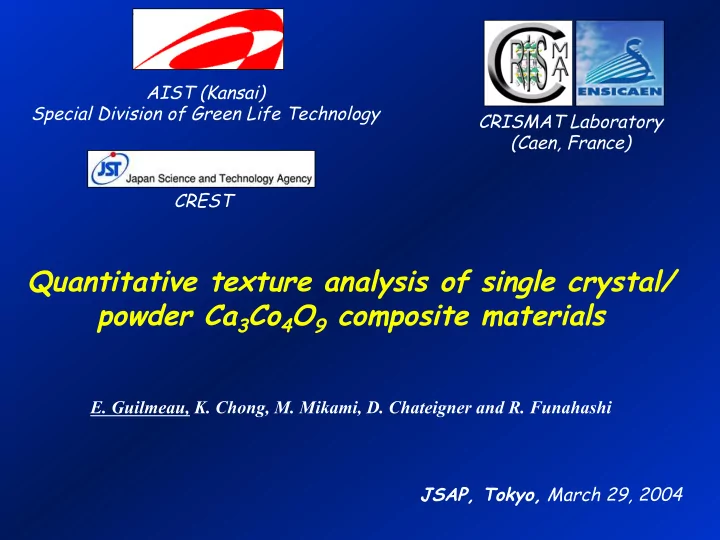

AIST (Kansai) Special Division of Green Life Technology CRISMAT Laboratory (Caen, France) CREST Quantitative texture analysis of single crystal/ powder Ca 3 Co 4 O 9 composite materials E. Guilmeau, K. Chong, M. Mikami, D. Chateigner and R. Funahashi JSAP, Tokyo, March 29, 2004
* Materials ** Quantitative Texture Analysis *** Texture ↔ TE properties Relationship
1 Materials Three composite samples : Powder + single crystals Ca 3 Co 4 O 9 Ca 2.7 Bi 0.3 Co 4 O 9 Single Crystals 30 Discs (Powder) Composition : 100%wt Powder 90%wt Powder + 10%wt Single Crystals 80%wt Powder + 20%wt Single Crystals Hot-Pressing
2 Materials (00 ℓ ) Texture Degree of orientation ??? (004) c (003) (002) (005) Intensity (u.a) Lotgering factor method Insufficient to quantify the texture strength!!! 20 40 60 2 θ (°) ◊ Only one sample orientation does not provide any information on the orientation distributions ◊ Overlapping → deconvolution (problem!!!) ◊ if only (00 ℓ ) are observed, f=1 for many possible degrees of orientation.
3 Quantitative Texture Analysis I ( , ) χ ϕ A quantitative approach hk ℓ D hk ℓ ( χ , ϕ ) = Distribution Density : r is necessary!!!! I hk ℓ (m.r.d) I hk ℓ ( χ , ϕ ) : Integrated intensity of the {hk ℓ } peak for the ( χ , ϕ ) orientation of the sample I r hk ℓ : Integrated intensity of the same sample without texture. (ab) planes χ θ ϕ
4 Quantitative Texture Analysis I ( , ) χ ϕ A quantitative approach 003 D 003 ( χ , ϕ ) = Distribution Density : r is necessary!!!! I (m.r.d) 003 (003) peak for various χ angles 8000 Intensity (u.a) 7000 6000 5000 4000 3000 χ (°) χ (°) 24 25 26 24 25 26 2 θ (°) 2 θ (°)
5 Quantitative Texture Analysis 100% Powder Integrated intensity I 003 ( χ ) (003) Peak for various χ angles Normalisation χ =45° Distribution Density D 003 ( χ ) χ =40° DDmax Distribution Density (m.r.d) χ =35° 10 χ =30° 8 χ =25° FWHD (°) 6 χ =20° 4 χ =15° 2 χ =10° 0 40 0 20 60 80 100 0 20 40 60 80 100 χ =5° χ (°) χ =0° DDmax 24 26 Texture 2 θ (°) FWHD
6 Quantitative Texture Analysis 80% Powder / 20% SC χ =35° SC Component 2800 Ca 3 Co 4 O 9 Powder Component 2600 Ca 2.7 Bi 0.3 Co 4 O 9 2400 χ =30° 3000 2700 2400 3200 χ =25° 2800 2400 3500 χ =20° 3000 23.0 23.5 24.0 24.5 25.0 25.5 26.0 26.5 2500 χ =15° 3900 3250 2600 χ =10° 4400 Ca 3-x Bi x Co 4 O 9 3300 2200 9000 χ =5° 6000 x 0 0.1 0.3 0.5 3000 SCs Powder c (Å) 10.7407 10.7576 10.7834 10.7921 400 χ =0° 7600 3800 24 25 26 2 θ (°)
7 Texture ↔ TE properties Relationship Powder Component FWHD: DDmax: 18 0% wt 10.34 m.r.d 36.25° 16 10% wt Distribution Density (m.r.d) 33.41° 13.00 m.r.d 14 20% wt 29.61° 15.67 m.r.d 12 10 8 6 4 2 0 Powder -2 0 20 40 60 80 100 χ (°) %wt Single crystals Resistivity Texture strength (Powder) SC
8 Texture ↔ TE properties Relationship Powder Component FWHD: DDmax: 14 18 0% SC 0% wt 10.34 m.r.d 13 36.25° 16 10% SC 10% wt Distribution Density (m.r.d) 33.41° 13.00 m.r.d 14 ρ ab (m Ω .cm) 20% SC 12 20% wt 29.61° 15.67 m.r.d 12 10 11 8 6 10 4 2 9 0 8 -2 0 20 40 60 80 100 200 300 400 500 600 700 800 900 1000 1100 χ (°) T (K) %wt Single crystals %wt Single crystals Resisitivity Texture strength (Powder)
Conclusion Direct Ø Degree of orientation quantitative texture analysis SC 2 texture components Ø Composite Materials : identifided and quantified Powder Ø Texture ↔ TE properties Relationship Ø Analysis suitable for any materials where preferential orientations must be quantified
Recommend
More recommend